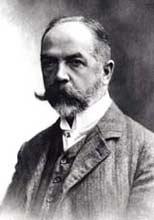Ferdinand Wittenbauer
Ferdinand Wittenbauer (born February 18, 1857 in Marburg an der Drau , † February 16, 1922 in Graz , Austria ) was an Austrian technician and co-founder of graphic dynamics, which is a branch of technical mechanics. From 1877 he worked as a professor at the Graz University of Technology . He also emerged as a poet and playwright.
Life
Ferdinand Wittenbauer was born on February 18, 1857 in Marburg an der Drau, today Maribor / Slovenia. He attended secondary school in Graz, graduated there and then graduated from engineering school at the Technical University in Graz. From 1876 to 1879 he was a member of the academic fraternity Allemannia Graz . In 1880 he completed his habilitation in theoretical mechanics. Despite tempting offers, he returned to Graz in 1884 after a year-long study trip through Germany to work at the "Mechanical Engineering School" - today's Faculty of Mechanical Engineering - until the end of his life.
plant
Wittenbauer's early scientific treatises can be assigned to the field of kinematic geometry. This discipline is dedicated to the relationships that exist between the speeds and accelerations of the various points on a plane in motion in a momentary situation. It was Wittenbauer's scientific merit to make the graphic methods of kinematic geometry usable for dynamics as well. His treatises, which will appear from 1904 onwards, are all preparatory work for his large-scale work on "Graphic Dynamics", which he was able to complete shortly before his death. The last chapter of the book is reserved for determining the flywheel calculation, Wittenbauer's most important contribution to transmission technology.
Long before his main work was published, Wittenbauer enjoyed international renown as the discoverer of a method for graphically determining the flywheel weight. He had also made a name for himself with a three-volume collection of "Technical Mechanics Tasks". This work, completed in 1911, has long been the most important German-language collection of exercises in the field of mechanics. It has been translated into foreign languages several times. In 1965 an edition was published in Spanish.
However, the ravages of time did not bypass Wittenbauer's findings. Powerful computer programs for simulating the movement of highly complex structures have quickly sidelined the methods of graphic dynamics. Wittenbauer's poetic work was also forgotten soon after his death.
Two pieces, " Filia hospitalis " (1902) and " Der Privatdozent " (1906), were popularly performed on German-speaking stages at the beginning of the century. Wittenbauer reflected on political, cultural and social components in the university and student life of that time. In "Filia hospitalis" the conflict between different student associations is dramatized. In "Privatdozenten", with the replacement of a university chair, academic life is at the center of the action. In his dramatic works as well as in his poetry and prose, Wittenbauer's German national sentiment is expressed. It is trimmed with a sentimental view of the German past, which was also common at the time.
Despite all the criticism, which can often be lightly applied from a distance, it must be appreciated that the technology in Graz had an excellent researcher in Ferdinand Wittenbauer, who as a teacher influenced several generations of mechanics students and, moreover, always supported it in his work occurred to overcome the sometimes too rigid boundaries between technical and artistic creativity.
The Wittenbauer parallelogram that he discovered and named after him enables the simple calculation of the center of gravity of any square. The following sentence applies: "The centroid of the Wittenbauer parallelogram is also the centroid of the associated square."
Ferdinand Wittenbauer died on February 16, 1922 in Graz (Styria) as a result of a stroke .
supporting documents
- ^ Letter to the editor Ferdinand Wittenbauer about the upcoming production in: Neues Wiener Tagblatt, 40 (1906) # 33, 13th (February 2nd, 1906)
- ^ Review of the performance in the Deutsches Volkstheater by HB [= Hermann Bahr ]: Theater, Art and Literature. German Volkstheater. Neues Wiener Tagblatt, 40 (1906) # 5, 13th (6th January 1906) The book edition is displayed at Konegen: Neues Wiener Tagblatt, 40 (1906) # 117, 36. (29th April 1906)
literature
- Helge Dvorak: Biographical Lexicon of the German Burschenschaft. Volume II: Artists. Winter, Heidelberg 2018, ISBN 978-3-8253-6813-5 , pp. 728-729.
- Tasks from technical mechanics, III volumes, 1907–1911
- Graphic dynamics, 1923
Web links
Holdings in the catalogs of the Austrian National Library Vienna:
http://data.onb.ac.at/rec/AL00006994
- Literature by and about Ferdinand Wittenbauer in the catalog of the German National Library
- www.uni-flensburg.de/.../wittenbauer-parallelogramm.html
- www.uni-flensburg.de/.../schwerpunkte.html
| personal data | |
|---|---|
| SURNAME | Wittenbauer, Ferdinand |
| BRIEF DESCRIPTION | Austrian technician and writer |
| DATE OF BIRTH | February 18, 1857 |
| PLACE OF BIRTH | Maribor |
| DATE OF DEATH | February 16, 1922 |
| Place of death | Graz |

